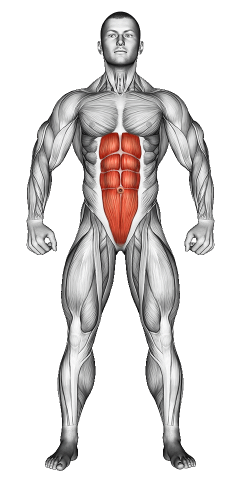Sit Up: Video Tutorial & Exercise Guide

Written By: Claude Michael
Updated: Oct 13, 2024
| Workout | Sit Up |
| Primary Muscle Group | Abs |
| Equipment Required | Bodyweight |
| Force Type | Pull |
| Mechanics | Isolation |
| Exercise Type | Strength |
| Difficulty | Beginner |
Sit Up: Video Tutorial & Exercise Guide
Sit-Up: Step-by-Step Guide
- Step 1: Lie flat on your back with your knees bent and your feet flat on the floor. Keep your arms crossed over your chest or place your hands behind your head for support.
- Step 2: Engage your core by pulling your belly button towards your spine. Press your lower back into the floor to avoid arching.
- Step 3: Begin the movement by curling your torso up toward your knees, lifting your shoulders and upper back off the ground.
- Step 4: Exhale as you lift, keeping your core tight and avoiding any jerking movements. Bring your chest towards your thighs, keeping your feet planted on the floor.
- Step 5: Slowly lower your body back to the starting position, controlling the descent to maintain tension in your core. Repeat for the desired number of reps.
Sit-Up: Overview
The sit-up is a classic core exercise that targets the rectus abdominis (your “six-pack” muscles) while also engaging the hip flexors. It’s one of the most popular and effective exercises for building abdominal strength and improving core endurance. Sit-ups help build a strong core, which is essential for maintaining proper posture and improving athletic performance.
Suitable for all fitness levels, sit-ups can be performed anywhere and can be modified to increase or decrease difficulty. They’re a great addition to any workout routine focused on building a stronger midsection.
Sit-Ups: Benefits
Sit-ups are highly effective for strengthening your abdominal muscles, improving core stability, and boosting overall endurance. A strong core supports good posture, reduces the risk of injury, and enhances performance in sports and everyday activities.
In addition to targeting the abs, sit-ups also engage the hip flexors and lower back, promoting full-body stability. Regularly performing sit-ups can lead to improved balance, better coordination, and a stronger core foundation for more advanced exercises.
Sit-Up: Pro Tips & Advanced Techniques
To get the most out of your sit-ups, focus on slow, controlled movements rather than using momentum to lift yourself. Keep your feet flat on the floor and avoid straining your neck. For an extra challenge, you can hold a weight plate or dumbbell across your chest or perform sit-ups on a decline bench to increase resistance.
Sit-Ups: Progression Plan
Beginner
Intermediate
Advanced
Sit Up: Frequently Asked Questions (FAQs)
What muscles do sit-ups target?
+Sit-ups primarily target the rectus abdominis (the six-pack muscles) but also engage the hip flexors, lower back, and obliques to a lesser extent.
Are sit-ups good for beginners?
+Yes, sit-ups are a great exercise for beginners. Start with a lower number of reps and focus on proper form before increasing intensity or adding resistance.
How often should I do sit-ups?
+Sit-ups can be included 2-3 times per week in your core workout routine. Combine them with other core exercises to target all areas of your midsection.
What common mistakes should I avoid?
+Avoid pulling on your neck or using momentum to lift yourself. Focus on engaging your core and maintaining a controlled movement throughout the exercise.
Can I modify sit-ups for more challenge?
+Yes, you can hold a weight plate or dumbbell for added resistance or perform sit-ups on a decline bench to increase the difficulty and intensity of the exercise.
Share
Don’t Wish for It, Work for It – Join the FlexXP Newsletter Today!
Thank you for signing up for the FlexXP Newsletter!
This site is protected and the Google Privacy Policy and Terms of Service apply.
